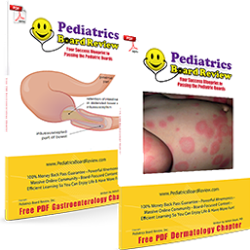How to Prepare For the Pediatric Boards
Getting to the pediatric boards is a major step in your career. Congratulations!
You’ve, no doubt, thought of exam preparation and winced. Think of it this way: the exam is the performance (or the game) and the exam prep is the rehearsal or scrimmage – authentic practice.
Pediatrics Board Review is here to make sure you are prepared and confident in your abilities to pass the boards.
The Three Pillars of Passing the Pediatric Boards
Passing the pediatric boards is hard. We know that. We’re not just an exam prep company. Pediatrics Board Review was created by a pediatrician who failed the pediatric boards and then did so well that the American Board of Pediatrics (ABP) asked him to write questions for them. So, we know what it’s like to go through these exams. We have the knowledge base and continuing education to help you pass.
There are three pillars for passing the pediatric board exams. They are content, technique, and commitment. Strength in each of these three key areas is crucial for success.
Content
Content is the fund of pediatric knowledge you develop as you prepare for the pediatric boards. You may think that this is a time when you need to gather all the resources, read countless books, and spend agonizing hours flipping from one cross-reference to another. But the truth is, when taking this exam, less is more. Turning to other textbooks, medical journals, and notes can be disastrous. What you need is a single source that is comprehensive, focused on board-relevant information, and allows for repetition in order to guarantee reinforcement of the concepts.
Using PBR's proven content will get you across the finish line. The reason is congruency. Our digital resources mirror our hardcopy resources precisely. Audio, video, online, and hardcopy resources in congruency allow for an easy preparation process as you weave in and out of different resources. This allows for greater repetition and greater repetition results in greater reinforcement. By using the tried and tested Pediatrics Board Review initial certification exam resources, you’re guaranteed a pass.
“Content is king.” Whether you are coming to PBR as a first-timer, or have failed previously, getting the right content in hand is the single most important aspect of passing.
Technique
Technique refers to how you process both individual board-style questions and how you approach the entire exam. Board-style questions are vastly different than living and breathing people. These questions are NOT miniature patients. The medical board exam is a standardized, artificial environment complete with its own set of rules and strategies to navigate.
The thing is, there are rules to the “board game.” Think of each question as a silent puzzle and there are strategic rules in place to help you solve it. This has to do with understanding the various styles of pediatric board exam questions, how to navigate those different styles of questions, and how to process the answer choices in a way that leaves only the answer that the question writers want. Once you are able to do this well, you can start to answer certain questions even without remembering all of the clinical medicine that you studied!
Also, PBR has noticed something significantly different with our members who are International Medical Graduates. Standardized tests, such as the board exam, are different from the board exams with oral and essay questions that they may have been used to in other countries.
A good example of this is the time expectation. 75 seconds is the recommended length of time per question. What do you do when the time remaining on a block of questions is only two or three minutes and you’re still not done? Do you continue to process the questions in order? If you cannot pace yourself at approximately 75 seconds per question, that could prevent you from completing your exam block. What if you knew the answers to those last five questions, but time ran out? So if you are an International Medical Graduate who has struggled with American standardized exams, know that you are not alone, and we can help.
Helping you understand how to decipher what the question writers are asking of you, how to systematically process answer choices and how to manage your time on the exam, are just a few of the many strategies we teach in PBR’s Test Taking Strategies and Coaching courses.
Commitment
Commitment is a huge reason why pediatricians fail the board exams. It takes a lot of effort and time to prepare yourself for the test. We recommend that low-risk, first-time test takers should study a minimum of 300 hours. For moderate and high-risk test takers, that number increases to 500. Regardless of which study plan you will need to follow, the commitment needed to take on 300-500 hours of board preparation is an absolute must for success.
PBR takes a deep dive into what is required to develop the study habits that you’ll need to get to where you want to be. This is done in our Live Test-Taking Strategies & Deep Study Course. PBR’s lectures around the concept of “Deep Study” are so impactful in multiple areas of life that they are often described as life-changing. There is no easy path toward passing your pediatric boards. But we will help you achieve this career milestone. It may mean studying every day, sacrificing time with your family, less time at your job, and maybe even passing up short-term opportunities in pursuit of the long-term goal. If you set these expectations for yourself you’ll be ahead of the game.
You can do it. We can help you.

Watch Your Free Video Training Session Now
Learn HOW to Answer Board Style Questions &
Be a Better Test Taker

High Risk vs Low Risk for Failing Your Pediatric Boards
What is your risk level for failing the pediatric boards? It’s a worthwhile question, right? Even though everyone needs to study and get ready for the exams, a high-risk candidate will need to put in additional effort. We can help you get there, and we can even help you identify whether you’re high-risk or low-risk.
Who is High-Risk?
A high-risk physician or resident may include someone who:
- Struggled to pass (or failed) ANY board exam
- Self-identifies as having difficulty with standardized board exams
- Is an International Medical Graduate
- Was classified “at-risk” of failing the boards based on In-Training Exam scores
- Comes from an “at-risk” residency program with a pass rate of less than 90% – click here to see where your residency program stands
- Has taken a year off from studying for the exam
- Scored less than 222 on the USMLE Step 1
Who is Low-Risk?
A low-risk physician or resident may include someone who:
- Has never failed any medical board exams
- Typically scores near, or above, the national average
- Self-identifies as someone who is a good test-taker and generally does well on standardized board exams
- Graduated from a US medical school
- Was never classified “at-risk” of failing the boards based on residency In-Training Exam scores
- Comes from a residency program with a pass rate of greater than 90% (click here and check your residency's pass rate)
- Will take the boards in the same calendar year as their graduation from residency
- Scored at least 222 on the USMLE Step 1
Use Our Risk Calculator To Find Out Where You Are
Are the Study Plans Different Based on Risk Level?
Yes. As we mentioned in the commitment pillar, a minimum of 300 hours is recommended for low-risk pediatricians and 500 hours of board preparation is recommended for moderate to high-risk pediatricians. Your risk profile should also help you select the right resources to maximize your chances of passing the pediatric boards.
For low-risk test-takers, the minimum set of resources we recommend would be included in the All Access Pass. This includes 100% of our Initial Certification exam educational resources. The All Access Pass primarily focuses on providing concise, board-relevant content presented to you through multiple modalities. This bundle gives you everything you need to take on the Content pillar we discussed above.
But, the most common bundle for test takers of the Initial Certification exam is the No Brainer Bundle. It includes resources to support all 3 of the key pillars needed to pass the pediatric boards. It includes PBR’s:
- All Access Pass
- Full Online Test-Taking Strategies Course
- Three 90-Day Personalized Study Schedules created by Team PBR
PBR’s No Brainer bundle is the best pediatric study package on the market, and it costs less than the price of a traditional video board review course.
We’ve helped thousands of pediatricians get through the initial certification exam, including those who have failed many times before. PBR offers focused, easy-to-use resources that will get you across that finish line. In fact, we back it up with a Money-Back First-Time Pass Guarantee. And of the thousands who have utilized our resources, less than 0.5% of pediatricians have asked for their money back.
We’ve helped them, and we can help you.
Are you ready to take on the pediatric board exams?




